THE FOREFATHERS OF THE MAYANS SET SAIL FOR MESO-AMERICA.

[Right: A beach in the Konkan.]
The time is about 1,500 BC. A fleet of Tamil ships in some harbor of the
Konkan or Kankon, a beautiful white sand coastline stretching from
todayÃs Maharasthra to the southern tip of Western India, raises anchor
and sails south to what is now the large island nation of Ceylon
(todayÃs Sri Lanka). Their goal is to sail to Patala or what is now
Mexico and Meso-America, leaving emigrant settlers there. During their
stay in Ceylon, they recruit skilled stone workers, skilled craftsmen,
and temple builders in the province of Maya, to build a new Tamil
civilization over or alongside an Akkad-type (Sumerian) civilization
that was already in Meso-America: that of the Olmecs or Olman.

[Right: Zikharis in Konkan.] The ancient Tamils were international
traders and colonizers. Wherever they went in the world, they left an
unmistakable imprint of their presence, such as place names, foods,
games, and temple buildings. Their temple buildings were usually
zikharis
(tiered or pyramidical temple platforms). Often, small entrances or
temples were located on each tier, but not always. On the top tier,
there was always a temple. On top if it often stood an ornate
rectangular steeple. However, circular domes or single spires often
stood on top of the temple as well. Zikharis usually varied in
appearance, according to the Dravidian or Tamil-derived cultures of the
host nations. But one thing never changed: the unmistakable presence of
Tamil influence.
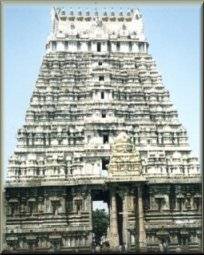
[Right: Kanchipuram Temple.]
ABOUT WHO THE PHOENICIANS REALLY WERE.
Before continuing with this article, I must clarify who the Phoenicians
really were. I first learned about these people who settled the earth,
about whom modern man knows nearly nothing, from the 19th century
British Orientalist George RawlinsonÃs book, Phoenicia. He was
considered as the leading authority on these hardy mariners. But even he
was off base. He said that the Phoenicians had no definite homeland but
occupied trading ports all over the Middle East. In the Western
hemisphere, they were called Puni but did not usually answer to that
name. Furthermore, he said they were a Mediterranean people. Yet, in
studying Hindu history, I discovered that they also existed in Central
Asia and India. But there, they were called Pani. Not even in India did
they call themselves Pani.
In his brief but enlightening little book, The Rig Veda ñ a History,
Bengali historian, Rajeswar Gupta, stated: ìÖin ancient times the Red
Sea and the Mediterranean Sea were connected together by a strait
through which the Phoenicians and Aryan trading ships entered the
MediterraneanÖAs that passage silted up the connection between India
and Europe broke off.î (p. 4.)
Had Professor Gupta been more acquainted with the Turkish-related
nations in Central Asia, he wouldÃve realized that the Phoenicians and
Aryans were the same people. The Phoenicians in the Middle East
eventually lost their awareness of being Dravidians, separating
themselves in many small city coastal states.
Even today, the Turkish peoples call themselves Ari. The forefathers of
the Turkish peoples also called themselves Pancha (Five) Krishtayas (The
Original Five Races of Mankind).
Like me, Professor Gupta intuited that the Phoenicians had originated in
Central Asia. Herodotus, the Greek Historian, did not mention the
Phoenicians as being a disorganized collection of city states, but as a
single political entity. I intuited that the original Phoenicia was
Anatolia (Turkey) and Bulgaria. Greece was at one time a part of
Phoenicia but later broke away. Even now the Greeks are a great sea
people as are the Turks. As a matter of fact, the famed Piri Reis 6000
years old map of the world was made from older Turkish maps. The
Mercateur map is another example.
UNDERSTANDING THE MEANING OF THE TERM PANI OR PUNI
If the Panis or Punis did not call themselves by those names, what do
those similar terms mean? This anomaly perplexed me because the word
exists in nearly all the languages of the world, even in Meso-America.
It is a fact that Panama was named after them because it was and is a
passage allowing boats to cross it. To find out what the term Pani
meant, I consulted the book, The Civilized Demons, the Harappans in Rig
Veda, by Malati J. Shendge: ìThey participated in the international
trade, taking the caravans from place to place, supplying goods
according to demand by bringing them from places where they were in
surplus. (p. 222.) In short, it means ìtraffic; moving from one place
to another.î The same meaning is found in the Nahuatl language: pan
(external location); pano; opano (crossing to the other side), etc. (See
Angel Maria GaribayÃs Llave del Nahuatl.) Even in our English
language, the prefix ìpanî means roughly the same thing:
ìall-encompassing; everywhere, etc.î
THE SUMERIANS WERE TURKS.
Many people find it difficult to accept that even the Akkad or Sumerians
were Turkish.
The Akkads (Sumerians) were Phoenicians. known also as Kads, Khatti,
etc., Originally, they were a Turkish (Kur, Tur, Tul, Tol, etc.) people
from what our Bible calls Eden, the Akkadian word for the Steppes
(Central Asia). Before the Great Flood, the Steppes or Eden was regarded
as an earthly paradise. However, when the Great Flood inundated what
are now the Altai, Tannu (Tiva, Teva, or Tuva), and Khakassia Turkish
republics, the survivors had to build their civilization all over again.
Many fled to what is now India, becoming Indians themselves, joining
the eastern part of the Northern and southern hemisphere as a single
nation.
Many of the post-flood tribes had been reduced to savagery. The Aryans
or Kurs (Turks) could not rehabilitate them. A Bulgarian king, known in
Indian mythology as the god of gold, good fortune and treasure, Kubera
(Khyber, Kheever, or the biblical Heber) decided to banish them to
Lanka. He and his followers, the Yakhus or Yakshas, thought they would
thrive more peacefully in that fertile, tropical country. However, not
even there would they civilize themselves. With the exception of the
Mayans of Altai and some Huna (Hunnish or Mongol) tribes, most of the
incorrigible nomadic tribes, called Rakshasas and Pisacas, preferred to
exist in the depths of degradation.
The Kubera people were called Nagas or Chans because the snake was their
emblem. According to the Ramayana, they peopled the world, taking about
10,000 years to do so. Kubera and his Yakhsas, along with the Mayans I
have already mentioned, then killed as many Rakshasas and Pisacas as
possible, taking the survivors to Patala.
In his book, Remedy the Frauds in Hinduism, historian Kuttikhat
Purushothoma Chon mentioned the Siberian origin of the Mayans. ìMaya
architects are mentioned in our epic Mahabharata. Maya people are in
Siam and East Asia. There is a place called Mayyavad in Kerala. The
Uttar Pradesh people have the meaning of Mayya as mother in phrases like
ëGanga ki Mayya.à There is a vast area in Russian East Siberia as
well as a river by name Maya.î (p. 28.)
The Cologne Sanskrit Lexicon defines the Maya as mathematicians
(measurers), astronomers, military strategists, magicians, wise-men, and
builders. Our Mesoamerican Mayans definitely fit this description.
Malati J. Shendge said that the Panis, Asuras, Yakshas, and Mayans were partners in a common cause.
DNA EVIDENCE OF A SIBERIAN ORIGIN OF OUR AMERICAN INDIANS.
Russian scientists have recently discovered that the DNA of people from
the Siberian Khakassia and Altai regions bordering on Tuva (also known
as Tannu, Tiva and Teva). The Mayans are supposed to have originated in
Altai. Later, the Kubera hordes took them to Ceylon where they became a
great people. To date, little research has been done on the DNA of the
Tuvans. The Russian scientists believe that the people of Tuva may have
even a higher DNA match with Amerindians. All that is remaining now is
to test the DNA of Mayans in other Asian lands, also that of our own
Mayans, the Inca Nahua, Maya, and Mayo clans, as well as that of the
Mexican Yaquis (Yakhs?) and Mayo (Maya)-two tribes speaking the same
language.
WHO WERE THE ASURAS?
Malati J. Shendge says that the Asura empire governed the Indus Valley
(Western India): ìÖthese peoplesÖwere well-versed in agriculture,
technology, engineering, sea-faring and trade and had established a
control on river waters by setting up dams and irrigation canals.î (The
Civilized Demons, p. 289,) Within this context, even the Phoenicians
were Asuras.
WERE THESE ASURAS AND THEIR ALLIES LIGHT OR DARK-SKINNED?
That the Aryans living in the coastal lands of Western India were
dark-skinned Dravidians, there is no doubt. Arrian said in his book
Indica: ìThe inhabitants upon the Indus are in their looks and
appearance not unlike the Ethiopians. Those upon the southern coast
resemble them the most, for they are very black, and their hair is also
black; but they are not so flat-nosed, nor have they woolly hair. They,
who are more to the north, have a great resemblance to the Egyptians.î
A certain Hindu nationalist group has tried to convince the Hindus that
the so-called ìAryan invasionî was a white Europoid lie in order to
oppress non-whites. However, they cannot explain why the one hundred
fifty million people living in the Turkish-related nations still call
themselves Ari (Aryan). Additionally, Krishtayas claimed to be all the
races of mankind.
[Right: A group of Tamils honoring my friend T. L. Subash Chandra Bose
at a religious meeting. He is the man in the background, wearing a
garland of flowers.] Dr. Polyat Kaya, a Turkish professor of historical
linguistics, wrote: ìPre-Iranian culture was Turanian culture and
civilization before theAryans. Indus civilization was also a Turanian
culture like the Sumerian culture was. Dravidian being related to these
ancient cultures ties them all together and also to Turkish. They are
all agglutinative languages although historians and linguists are
conditioned not to mention the name Tur/Turk.î (Istanbul
allingus@hotmail.com.)
The traditional garb of Dravidian men has not changed in thousands of
years. Like the ancient Assyrians, they wear long flowing skirts
reaching to their ankles.
Many scholars agree that Asura was Assyria, an empire extending from
West-Central Asia down to the tip of Southwestern India. If I am correct
in assuming that the Dravidians were the Asuras, they are mentioned in
Genesis as Ashur, son of Shem. (Genesis 10:22.)
The ancient Phoenicians claimed that they originally came from the lands
alongside the ìErythean Sea.î The ìErythean Seaî is now the Arabian
Ocean,î extending from Pakistan throughout all the western coast of
India.
WERE THE OLMECS TURKISH?
The Olmecs or Olman were the first civilization in Meso-America.
Although there are abundant physical and linguistic artifacts of their
existence, only the Nahuatl-speaking tribes and the Mayans knew
something about the Olmecs or Olman as a people. For certain, we know
that they were Turks because Olmak and Olman are the Turkish names for
Adam. Perhaps they called themselves thusly because they were the first
inhabitants of Mexico.
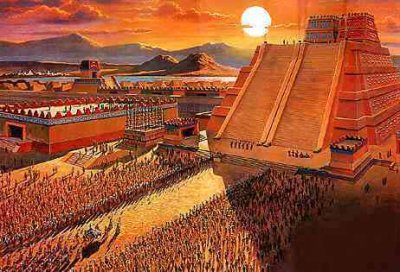
[Right: ArtistÃs idea of what the ancient Olmec city of La Venta looked
like.]
The Olmecs supposedly entered Western Mexico in boats, crossing the then
navigable Isthmus of Tehuantepec. They first settled on the east coast
of Veracruz by the river Papaloapan. The Nahuatl-speaking people
couldnÃt pronounce ìB.î Papaloapan was probably Babalu-apan
(Babylonian Crossing).
The Olmecsà Zikhari (Temple Mounts) were similar to those of the
Sumerian Zigurrats and with virtually the same name: Zicualli and
Zacualli. Because the Nahuatl tribes couldnÃt say ìL,î it was
probably a dialectical version of Zigurrat: Zicuari.
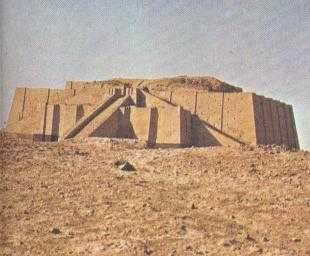
[Left: A central Asian Ziggurat with upper elevations eroded by
centuries.] Hundreds of years after settling on the coast, they moved in
to the central highlands of Mexico and as far northward as the
present-day state of San Luis Potosi. Traces of them may eventually be
found as far as Southwestern United States.
As they multiplied and spread out, they eventually forgot they were
Olmecs and Olman. About all they could remember is that they came to
America in boats: Nava or Nauvak (Nahua or Nauwak), ìship people.î
Eventually, Nauvak changed to Anauwak (no longer ship people). Even
today, the Nahuatl word Anahuac means ìbetween two waters.î The
Nahuatl-speaking tribes also called themselves Toltec, derived from
Toltika, meaning ìSons of Tulan or Turan.î When the Spaniards arrived
in Mexico, the Aztecs called them ìTules,î thinking they, too, were
Turks.
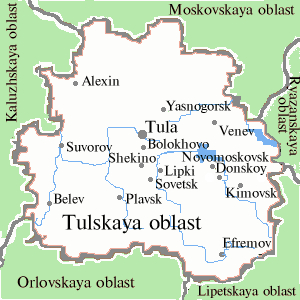
[Above: Map of Tula in Siberian Russia. Did the Aztecs come from this Tula?]
They and the Sumerians prayed to the same mother goddess:
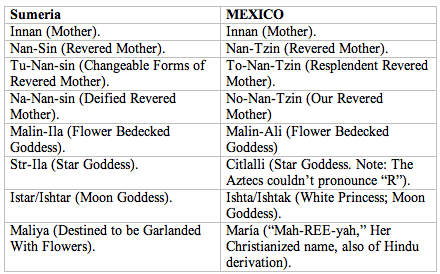
Southern Persia, Afghanistan, and Pakistan had several different names:
Sivapuri (The Region of God Shiva),
Sivabhu (Sacred Land of Shiva),
Sivapuni (The Purity of Shiva), and
Shivulba (The Womb, Origin, or Cave of Shiva). The Pueblo Indians called their underworld or place of origin
Sibapu or
Sibapuni; for the Mayans, it was
Shibalba, their "underworld" and place of the gods. The linguistic and functional similarities of the Hindu
Sivabhu, Sivapuni, and
Shivulba with the Puebloan
Sibapu, Sivapuni, and the Mayan
Shivalba (Xibalba) are too nearly exact to be coincidences.
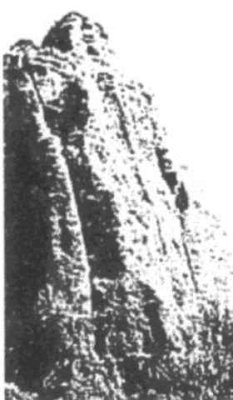
[Right: The "Sumerian" Statue in Tepoztlan, Morelos.]
A
Tepe was a low, steep hill surrounded by a village. The
Tepe
was used both as a fortress in case of attack and as a religious center
honoring the villageÃs special deity-often a mother goddess. A few of
the many hundreds of Tepes scattered over
Sivabhu, even into the Middle East, are
Tepe Yaya, Tepe Ya, Tepe Kilize, Tepe Liman, Tepe Catal, Tepe Godin, Tepe Cora, etc.
Mexico is the only region outside the Middle East and Central Asia,
where we find hundreds of these combination protective and holy hills
called Tepes. Some of these are
Tepatit·n, Tuxtepec, Tepec, Tepic, Mazatepec, Tepetatas, Tepantita, Tepetzintla, Tepuste, Tepetlix, Tepetlalco, ad infinitum.
In ancient
Sivabhu, the deities located at the tops of these tepes were called
Yah, Yakh, Yakhu, Yaksha, Yakshi etc., meaning ìGuardian Angel.î The leading Mexican
Yakshi (female guardian angel) had her sanctuary atop what is now
Tepeyac (Hill of the Guardian Angel) in Mexico City. She is now the Virgin of Guadalupe.
Eventually, the non-Olmec tribes in Mexico, if there were ever any at
all, copied their civilization after them. The Aztecs claimed that they
had once lived in what are now the Florida Cays. When their city went
under water, a sea-faring group saved them, dumping them on the Mexican
mainland. In their annals, they said they adopted the civilization of
the people already there.
The Nahuatl-speaking tribes and the Mayans told the Spaniards that a
people called Tamoan-chan or Tamuan-chan also mixed with the Olmecs.
These would be people from some part of Oceania, such as Samoa or New
Zealand. (See GaribayÃs Llave del Nahuatl.) The word ìChanî meant
ìPlace of Snakesî
In the 1950s, I visited a strange rock formation near Tepoztlan,
Morelos, resembling a badly eroded Sumerian statue. Some people think it
is just a natural formation, but I do not. There are other man-made
formations near it, that are definitely not Aztec.
THE MAYANS WERE TAMILS.
I am now ready to return to the hypothetical voyage of Tamils to
America. They probably used two types of maps. The map below-left shows
Mt. Meru with petals pointing in four directions. The left petal points
toward a distant land called Ketumal or Chetumal. In order to reach that
land, they had to go eastward in order to avoid sailing around the tip
of Africa. They knew where they were going, for they had been there
before! The map below-right was their own map of the world.
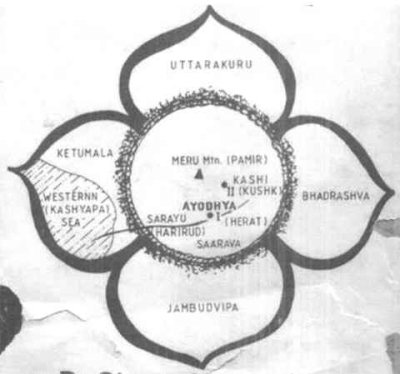
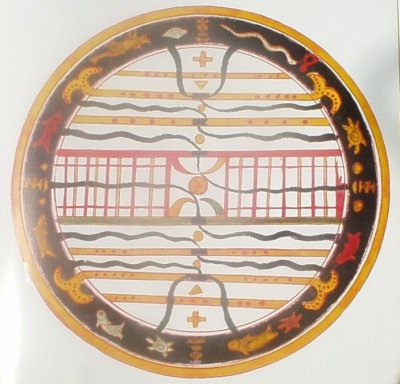
The Mayans said that the land of their forefathers lay 150 days westward.
When the Tamils arrived in North America, they crossed over to what is
now the Caribbean Sea, through the Isthmus of Panama (The Great
Crossing). After coming out the other side, they docked in the safe
harbor of Chetumal. It still bears the same name. Chetumal harbor is in
Belize. Belize derives from Belisha (God Shiva).

[Right:
Photo of Chetumal harbor in Belize.]Later, they left Chetumal, sailing
up the coast to a place reminding them of the beauty of their old home
in Konkan. They dropped anchor and made their first home in America
there. Not surprisingly, they decided to name their new home Kankun
(Cancun). After thousands of years, the last syllable has barely changed
in pronunciation.
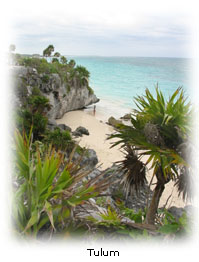
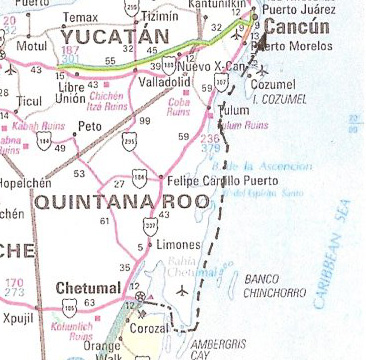
[Left: Beach scene in Tulum, Cancun area. Right: Map showing their voyage from Chetumal to Cancun.]
When the Tamils settled in Yucat·n, they built their typical zikharis,
such as those of Tikal and Palenque. At Tikal, they stained their stone
monuments a reddish color, just as they had done back in the Konkan.
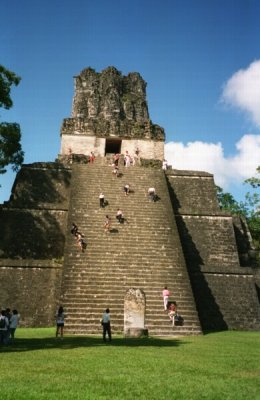
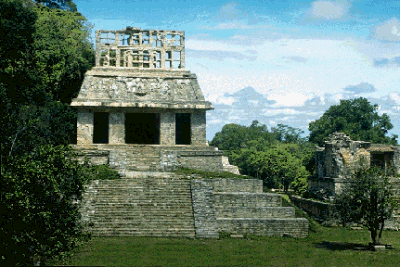
[Left: A Tikal Zikhari. Right: A Pelenque Zikhari.]
People are surprised to see stone images of elephants in Mayan country,
such as the following one in Copan. It may be a reminder of the
elephants in India.
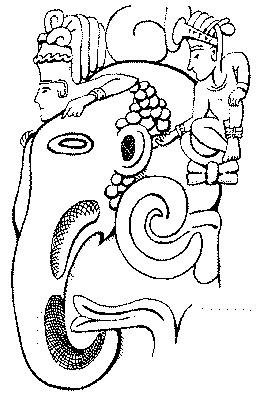
[Right:
Stone etching of a Hindu mahout, complete with turban, riding on the
head of an elephant.] Some authorities, who do not agree with me that
the Mayans came from abroad, think Southern Mexico once had elephants.
The truth is that they worshiped a long-nosed god (Chac) or elephant,
just as the Hindu Tamils worshiped the elephant-headed Ganesha in India.
Chak was the long-nosed Mayan God of thunder, lightning, rain,
and crops. His elephantine trunk sprayed water on the earth. His
equivalent in other parts of the world was
Zeus, Dyaus, Jupiter, Ca, Jah, Ju, Jahve, Jehova Jeho, Sakh, Sagg, Sa-ga-ga, Sakko, Zagg, Zax. a.k.a.
Zeus,
is often depicted holding a serpentine thunderbolt and a grail, or
someone is handing it to him. The Mayan Chak is equally depicted.
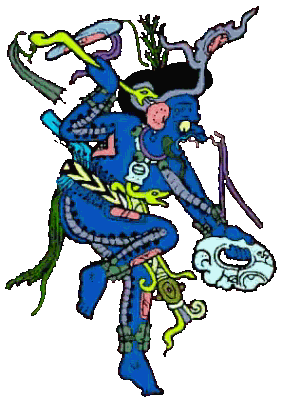
The Mayan god Chac.
LINGUISTIC EVIDENCE THAT THE MAYANS WERE FROM CEYLON.
They gave several names that directly and indirectly identified Ceylon:
Shilanka (Xilanca) - an ancient name of Ceylon (Zeilan-Ka).
Shikalanka (Xicalanca) - Ceylon. In Tamil, Shikalam.
Itzamna was one of their culture heroes. He claimed to have come
from a western country. Isham, meaning 'Tiger, ""Land of Gold," was a
Dravidian name of Ceylon. The Na in Isham-na is an honorific.
Ishbalanka (Xbalanca), another culture hero. In Tamil, it means
"Shiva of Lanka." India's God Shiva was supposed to have made the
footprint on top of Adam's Peak in today's Sri Lanka.
Shibalba, The Mayan underworld. This word stems From the Sanskrit Shivulba, meaning ìfrom the fountainhead of God Shiva-Mt. Meru, in India.î
Palenke (Palenque). This name derives from the Tamil Pal-Lanka, meaning "Protectorate of Lanka." Ancient Lanka was IndiaÃs ìAtlantis.î
The Yaxilan (Yakshilan) Mayan ruins. This name means ìThe Ceylon Yakhsî in Sanskrit.
Ceren, a name of Ceylon. Some Mayan ruins in El Salvador are called Ceren.
Lacandon, a tribe of Yucatan. India's god Kubera banished the
Laks, a Tartarian Huna or Rakshasha tribe from Northern India to Ceylon,
giving the country one of its many names and becoming the Lakan or
Lakam people. The Don in Lacan-don derives from Dan (Tannu or Dannu?).
(See the online Cologne Sanskrit and Tamil dictionaries for comparison
of ancient Ceylon names with those of Mayan tribes and places.)
THE THREE PROVINCES OF ANCIENT CEYLON.
Ancient Ceylon was divided into three provinces:
Maya, the central division of the island;
Ruhuna (Soul of Huna Land), and
Pihitee, the northernmost of the three. The Ceylonese
Maya
were known for their impressive astronomical knowledge, architectural
marvels, temples, and irrigation ponds. (Reference: The History of
Ceylon, by William Knighton, first published in Colombo Ceylon, in
1845.)
One of the names of Ceylon's cult religions was
Mayon. It still exists among a few aboriginals living on the island.
Most of the Rakshasa and Pisaca bad boys were Tartarian
Hunas, They came from
Huna-Bhu,
meaning ìHunas (Tartars) from the Sacred Land around Mt. Meru.î Many
of these tribes were cannibalistic, given to intertribal fighting,
practitioners of human sacrifice in their religious rites, flattened the
foreheads of their babies, took scalps in battle, and observed other
customs attributed to many Amerindian tribes. The Mayans remember them
as the culture hero,
Hunapu (Huna-Bhu?).
Had the natives of Meso-America been able to pronounce the "ST" combination, today's Yucatan would be
Yucasthan (Yakhuthan?). Even today, many Mexican Indians and peasants cannot pronounce this combination. For example, instead of
CÛmo est·? (How are you?), they can only say,
"øCÛmo t·?"
Guatemala derives from Sanskrit
Guadhaamala, meaning
Guha (Cosmic Intelligence) +
Dha (Serpentine) +
Amala
(Umbilical Cord), the Sacred Umbilical Cord Linking Western Asia and
India with Meso-America. Besides the Ceylonese and Tamil tribal names
Yakkha, Maya, and
Lak in Maya country, there are also the
Lenca and
Rama
tribes. The Mayan lowlands are even called Guanacaste, meaning The
Western Enlightened Nagas. It is assumed that the Olmecs spoke Nahuatl
because of the place-names they left behind. The Olmecs called the Maya
country in Southeastern Veracruz, Coatzacoalcos (Snake Sanctuary). Snake
Sanctuary was none other than the home of the Western or American
Nagas.
ìOriginally, the Asuras or Nagas were not only a civilized people, but a
maritime powerÖ,Kadru, the mother of serpents, compelled Garuda (the
Eagle or Hawk) to serve her sons by transporting them across the sea to a
beautiful land, which was inhabited by Nagas. The Asuras (Nagas) were
expert navigators who possessed very considerable naval resources and
had founded upon distant coasts.î (The Encircled Serpent by M.
Oldfield, p. 47.)
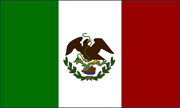
Even
today, the Mexican flag has an Eagle with a serpent in its mouth,
representing the arrival of the ancient Mexicans to Meso-America. It
also represents the arrival of the Meshika to what is now Mexico City.
[Right: Mexican flag.] The Tamils and all the tribes of Meso-America,
from Mexico to Panama, played the same board game: Pachesi. The
Meso-Americans called it by a linguistically similar name: Patolli.
(Note: CH and T are linguistically similar. LL was the only way the
Renaissance Spaniards could approximate the sounds of Z and J. This
proves that Patolli derived from Pachesi.) I myself saw a Patolli board
game at the National Museum of Costa Rica, in San Jose.
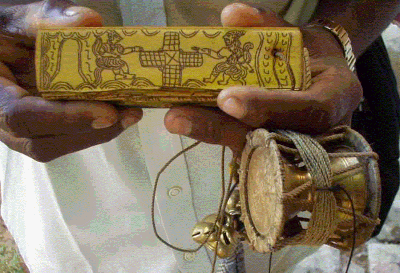
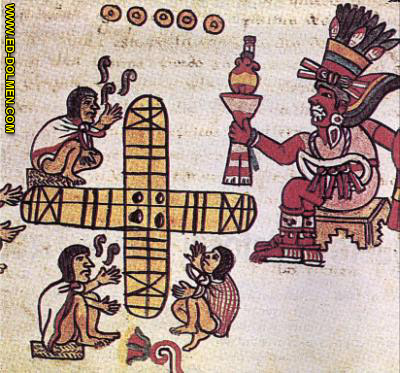
[Above
Left: Mr. Subash Bose displays an ancient Tamil Pachesi board kept as a
relic in the temple of his area. The Tamils and all the tribes of
Meso-America, from Mexico to Panama, played the same board game:
Pachesi. Right
: The Meso-Americans called it by a linguistically similar name:
Patolli. (Note: CH and T are linguistically similar. LL was the only way
the Renaissance Spaniards could approximate the sounds of Z and J. This
proves that Patolli derived from Pachesi.) I myself saw a Patolli board
game at the National Museum of Costa Rica, in San Jose.]
BOTH THE MEXICAN INDIANS & TAMILS ATE TAMALES WITH THE SAME NAME!
The Tamils and Turks even gave some of their favorite dishes to the
ancient Mexicans, and with the same names! I will name just two of them:
Tamales and Corundas. The ancient Tamils were known as Tamils or
Tamals. One of their favorite foods was a type of paste or filling
wrapped in bamboo husk. Even in Tamil Nadu it is called Tamal. The
Michoacanos have a similar triangular shaped tamal called Corunda. In
Turkic it would be kur-unda (Turkic dough).
My Tamil Nadu friend, Mr. Subash Bose, pointed out to me the fact that
Hindus often worship cobras and that the Mayans worshipped rattlesnakes.
He said that Mayan huts look exactly like those in Tamil Nadu.
The Kuberas even gave their name to North America. The Meso-Americans
told the Spaniards that North America was Quivira (Land of the Khyber
People).
Most of us have heard of the Mayan holy book,
Chilam Balam. Chilan or
Chilam is a title of Mayan priests.
Balam is the Mayan name for Jaguar. In Sanskrit,
Cheilan = Ceylonese and
Vyalam = tiger; lion; hunting leopard. ìJaguarî probably stems from the Sanskrit
Higkara, meaning Tiger-like or ìsounding like a tiger.î
The Mayans called their ìQuetzalcoatlî Kukulcan and Gukumats. These
names appear to derive directly from the Turkic language. Kuk or Gok
derived from the Turkic Gog and Gok, names of ancient Turkish tribes.
Ulu means ìhigh placed.î
Mats derives from
Masi, the Turkic word for ìMessiah.î
Khan is a Turkic word for ìKing.î Therefore,
Kukulcan=Gogulkhan (The Revered King of Gog.)
Gukumats=Gokumasi (The Revered Gok Messiah).
The presence of Dravidian, Turkic, and Sanskrit words in America
shouldnÃt surprise anyone, for the Aryans and Indians (Ramanaka)
traveled together throughout the world. In his book, El OrÃŒgen de los
Indios, the Spanish priest, Gregorio PÈrez, wrote that the Caribbean
Indians said that their founding fathers were the Kuru-Rumani.
Some Dravidians think Sanskrit sprang from Dravidian, but my research
does not indicate this. Many of the Turks also spoke Aramaic, for at one
time it was more generally spoken than it is now. The Turkish linguist,
Professor Polyat Kaya, states that such languages as Sanskrit,
Dravidian, Hebrew, Chinese, and many others are anagrams derived from
Turkish. He also said that the Mayan language derives from Turkish.
In this article, I have just presented a tiny part of the evidence in my
possession, pointing to the Indian and Ceylonese origins of the Mayans.
I have decided to end this article by recounting what the Jesuit priest
Francisco Xavier Clavigero wrote in Volume I of his Historia Antigua de
Messico (Ancient History of Mexico). Clavigero said that the Chiapaneco
Mayans told him that a grandson of Noah, Votan, took people to people
America. He was from the Chan (Naga or Serpent) tribe. They said that he
came from the East, bringing seven groups with him. Two other leaders
(Groups?) had also previously brought in settlers: Igh and Imox. He
built a great city, now known as Palenque, call ìNauchan,î meaning
City of the Serpents. When Noah emerged from the Ark, he and his people
built their first city, calling it Nashan (The Noachide Chan).
Votan founded three tributary monarchies called Tulan, Mayapan, and
Chiquimala. The ruins of Tulan are those of Tula, Hidalgo, Mexico.
Mayapan is the Yucatan peninsula itself. I have not yet located the
region of Chiquimala. Perhaps it is Guatemala or the Mayan province of
Tzequil.
Like many Europoids ignorant of India and its history, Clavigero tried
to place them in Cartagena, Africa, Rome, and even Spain. But he at
least intuited that the early Mayan settlers were Phoenicians.
Had he been more knowledgeable about ancient India and Ceylon, he would
have known that they were Ceylonese, for in Tamil, VALAM POTAM means
ìPlace of Boats.î Valam Potan (Ceylon) was located between the
Tropics of Cancer and Capricorn, where the trade winds are. The
differences between Valum Votan and Valam Potam are trivial.
Notice the following map showing the sea and land routes of the ancient
Tamils. Below it, youÃll notice the words Oceanus Indicus (Indian
Ocean). The ancient maps which the Spaniards used to get to America
showed the same terms: Mar Indica; Oceanus Indica. From where did they
obtain those maps showing that the eastern end of Oceanus Indica was
America?
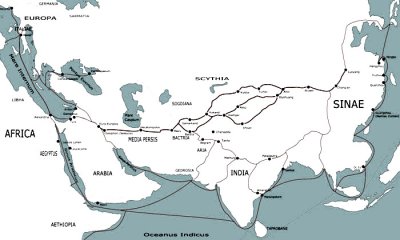
Map showing the land and sea routes of the ancient Tamils.
The stone heads staring at the sea, from the shores of Easter Island,
tell us a lot about the ancient sailors theyÃre supposed to represent.
Notice their ìheadpieces.î Could they be Tamil turbans?
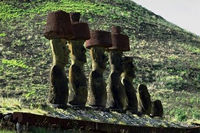
The stone heads of Easter Island.
SOME PARTING THOUGHTS
Many people donÃt know that the Mayans and Toltecs werenÃt the only
immigrants who entered the Americas through Chetumal, the ìPlymouth
Rockî of many American Indians. I can name several United States Indian
tribes who also landed there. Their origin stories say so in plain
words.
In view of what I have said in this article, who is better qualified to
identify the origins of our American Indians? Our Europoid academics? Or
the Turks, Hindus, and American Indians?
All kinds of speculations have been made, many mystical, about the
ancient sea-farers known as Wotan, Woden, the German Wuotan, the Yap
Island Paathan, and the Philipine Bataan. Even today, a large tribe of
Pakistanis are called Pathan. Votan was never a single person. He was
really a ìnation of sailors.î This ancient nation of sailors and
adventurers is still with us: The Dravidian Tamils!
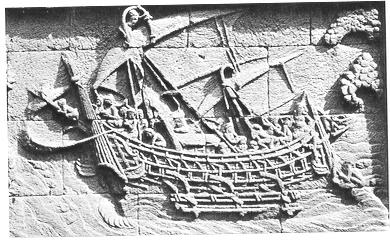
A Tamil ship.
As with GeneÃs Viewzone article about the biblical Mesechs, this
article will also be a chapter in an upcoming book he is preparing about
the origins of our Amerindians. His latest book, What Strange Mystery
Unites the Turkish Nations, India, Catholicism, and Mexico?, can also
provide interested readers with some fascinating insights about the
ancient world.
Ref: http://viewzone2.com/ancientturksx.html




 [Right: Zikharis in Konkan.] The ancient Tamils were international
traders and colonizers. Wherever they went in the world, they left an
unmistakable imprint of their presence, such as place names, foods,
games, and temple buildings. Their temple buildings were usually zikharis
(tiered or pyramidical temple platforms). Often, small entrances or
temples were located on each tier, but not always. On the top tier,
there was always a temple. On top if it often stood an ornate
rectangular steeple. However, circular domes or single spires often
stood on top of the temple as well. Zikharis usually varied in
appearance, according to the Dravidian or Tamil-derived cultures of the
host nations. But one thing never changed: the unmistakable presence of
Tamil influence.
[Right: Zikharis in Konkan.] The ancient Tamils were international
traders and colonizers. Wherever they went in the world, they left an
unmistakable imprint of their presence, such as place names, foods,
games, and temple buildings. Their temple buildings were usually zikharis
(tiered or pyramidical temple platforms). Often, small entrances or
temples were located on each tier, but not always. On the top tier,
there was always a temple. On top if it often stood an ornate
rectangular steeple. However, circular domes or single spires often
stood on top of the temple as well. Zikharis usually varied in
appearance, according to the Dravidian or Tamil-derived cultures of the
host nations. But one thing never changed: the unmistakable presence of
Tamil influence.
 [Right: Kanchipuram Temple.]
[Right: Kanchipuram Temple.]  [Right: ArtistÃs idea of what the ancient Olmec city of La Venta looked
like.]
The Olmecs supposedly entered Western Mexico in boats, crossing the then
navigable Isthmus of Tehuantepec. They first settled on the east coast
of Veracruz by the river Papaloapan. The Nahuatl-speaking people
couldnÃt pronounce ìB.î Papaloapan was probably Babalu-apan
(Babylonian Crossing).
[Right: ArtistÃs idea of what the ancient Olmec city of La Venta looked
like.]
The Olmecs supposedly entered Western Mexico in boats, crossing the then
navigable Isthmus of Tehuantepec. They first settled on the east coast
of Veracruz by the river Papaloapan. The Nahuatl-speaking people
couldnÃt pronounce ìB.î Papaloapan was probably Babalu-apan
(Babylonian Crossing).
 [Left: A central Asian Ziggurat with upper elevations eroded by
centuries.] Hundreds of years after settling on the coast, they moved in
to the central highlands of Mexico and as far northward as the
present-day state of San Luis Potosi. Traces of them may eventually be
found as far as Southwestern United States.
[Left: A central Asian Ziggurat with upper elevations eroded by
centuries.] Hundreds of years after settling on the coast, they moved in
to the central highlands of Mexico and as far northward as the
present-day state of San Luis Potosi. Traces of them may eventually be
found as far as Southwestern United States. 

 [Right: The "Sumerian" Statue in Tepoztlan, Morelos.]
[Right: The "Sumerian" Statue in Tepoztlan, Morelos.]

 [Right:
Photo of Chetumal harbor in Belize.]Later, they left Chetumal, sailing
up the coast to a place reminding them of the beauty of their old home
in Konkan. They dropped anchor and made their first home in America
there. Not surprisingly, they decided to name their new home Kankun
(Cancun). After thousands of years, the last syllable has barely changed
in pronunciation.
[Right:
Photo of Chetumal harbor in Belize.]Later, they left Chetumal, sailing
up the coast to a place reminding them of the beauty of their old home
in Konkan. They dropped anchor and made their first home in America
there. Not surprisingly, they decided to name their new home Kankun
(Cancun). After thousands of years, the last syllable has barely changed
in pronunciation.



 [Right:
Stone etching of a Hindu mahout, complete with turban, riding on the
head of an elephant.] Some authorities, who do not agree with me that
the Mayans came from abroad, think Southern Mexico once had elephants.
The truth is that they worshiped a long-nosed god (Chac) or elephant,
just as the Hindu Tamils worshiped the elephant-headed Ganesha in India.
[Right:
Stone etching of a Hindu mahout, complete with turban, riding on the
head of an elephant.] Some authorities, who do not agree with me that
the Mayans came from abroad, think Southern Mexico once had elephants.
The truth is that they worshiped a long-nosed god (Chac) or elephant,
just as the Hindu Tamils worshiped the elephant-headed Ganesha in India.

 Even
today, the Mexican flag has an Eagle with a serpent in its mouth,
representing the arrival of the ancient Mexicans to Meso-America. It
also represents the arrival of the Meshika to what is now Mexico City.
Even
today, the Mexican flag has an Eagle with a serpent in its mouth,
representing the arrival of the ancient Mexicans to Meso-America. It
also represents the arrival of the Meshika to what is now Mexico City.










